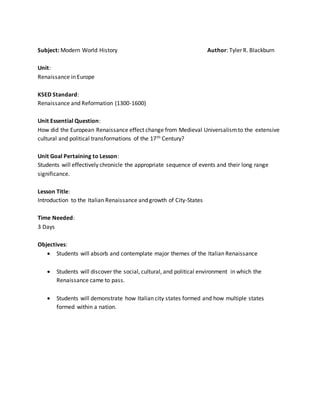
Renaissance Lesson Plan
- 1. Subject: Modern World History Author: Tyler R. Blackburn Unit: Renaissance in Europe KSED Standard: Renaissance and Reformation (1300-1600) Unit Essential Question: How did the European Renaissance effect change from Medieval Universalismto the extensive cultural and political transformations of the 17th Century? Unit Goal Pertaining to Lesson: Students will effectively chronicle the appropriate sequence of events and their long range significance. Lesson Title: Introduction to the Italian Renaissance and growth of City-States Time Needed: 3 Days Objectives: Students will absorb and contemplate major themes of the Italian Renaissance Students will discover the social, cultural, and political environment in which the Renaissance came to pass. Students will demonstrate how Italian city states formed and how multiple states formed within a nation.
- 2. Procedure: Day 1: Renaissance: Innovation or Continuation? Introduction/Hook: Group discussion: Are you living through a period of great social, cultural, and political change? If so, how? If not, why? Direct Instruction: Content Lecture and teacher led discussion. (Construction of Knowledge) Students organize information, consider alternatives, evaluate, reflect on their learning, and focus on in-depth understanding of core content. Content Covered: Perceived achievements of Renaissance Innovations of Medieval Era Religious Life Government Society True Renaissance: Literature and Art Urban resurgence Students: Absorb, discuss, take study notes, question Activity: Live History – Development of City States Part 1 (Collaboration and Authentic Learning) Students work collaboratively in groups, develop multiple perspectives and solutions, engage in substantive oral, written communication, work on real world tasks, and do problem solving in context. Students will divide into pairs or groups, and will be assigned as leadership of a Historical Italian City State. Students will research and craft a pennant or flag of their respective city states, complete with Historical insignia and designs to be used in later activities. Live History activity will evolve throughout the duration of the Unit. However, other activities will also be utilized. Assessment: Writing response. Should the Renaissance be viewed as an era of great change or a continuation of previous norms? What aspects of civilization, if any, changed? Which if any, remained the same? Standard #4: Societies experience continuity and change over time
- 3. Day 2: Functions and Institutions of the Italian City State Anticipatory Set: Individual writing. Autonomy – Define (Use Webster’s) What does it take to achieve autonomy? Does anyone truly have complete autonomy? Direct Instruction - Content Lecture and teacher led discussion. (Construction of Knowledge) Students organize information, consider alternatives, evaluate, reflect on their learning, and focus on in-depth understanding of core content. Content Covered: Social Hierarchy Community & Civic Loyalty Localized Autonomy Major Cities: Florence, Milan, Venice, Rome, Naples etc. Republic/Popular Sovereignty Class/Factional Rivalry Guelfism/Ghibellinism Signoria/Condottiere Feudal lordship/Parliamentary republicanism Merchant aristocracy Students: Absorb, discuss, take study notes, question Activity: Live History – Development of City States Part 2 (Collaboration and Authentic Learning) Students work collaboratively in groups, develop multiple perspectives and solutions, engage in substantive oral, written communication, work on real world tasks, and do problem solving in context. Students, having established which city state they lead, will now engage in commerce, diplomacy, and possibly conflict with each other within the parameters of historical authenticity. Die and other gaming equipment will be utilized for simulation purposes. Teacher will preside over activity as arbitrator and harbinger of events Assessment: Writing response What are the 5 major city states of Renaissance Italy? What systemof government did each utilize? What major industry did each sustain? Standard #3: Societies are shaped by beliefs, ideas, & diversity
- 4. Day 3: Wars of Expansion Anticipatory Set – Partner - discussion/writing Students meet with their City State partners to discuss: As of today, in our live history activity, which city state are you currently most at odds with? Which city state are you most friendly with? What do you plan to do with each? Direct Instruction - Content Lecture and teacher led discussion. (Construction of Knowledge) Students organize information, consider alternatives, evaluate, reflect on their learning, and focus on in-depth understanding of core content. Content Covered: Decline of Imperial and Papal dominance Diplomacy, Rivalry, Warfare, Mercenaries State Expansion, Taxation, Civic Power Growing Bureaucracy – Catasto Individualism Mercantilism Regional Power Centers Gian Galeazzo Visconti/Filippo Maria Visconti Cosimo de Medici – Diplomatic Revolution Wars of the 15th Century Students: Absorb, discuss, take study notes, question Activity: Live History – Development of City States Part 3 (Collaboration and Authentic Learning) Students work collaboratively in groups, develop multiple perspectives and solutions, engage in substantive oral, written communication, work on real world tasks, and do problem solving in context. Students will continue to develop their city states with economics and diplomacy becoming increasingly complex. Groups which are eliminated will take up the role of international powers making the game more intricate. This will help segue into the subsequent unit: Growth of European National Monarchies. Assessment: Writing Response Describe the forces that led the Italian City States to pursue expansion. What were the results of the Italian Wars of the 15th Century? How did the wars impact the relationships between the states thereafter? Standard #5: Relationships between people, places, ideas, and environments are dynamic.
- 5. Accommodations: The following accommodations will be utilized throughout the unit for any student needing extra support in understanding content and language. Instructional Modifications based on level of English Proficiency Modeling Use of Illustrations and Diagrams Use of Substitution, Expansion, Paraphrase, and Repetition Vocabulary Explain key concepts Use of Word Banks Visuals and Graphic Organizers Music Videos/ Interactive Strategies and Cooperative Learning Settings Flexible Grouping Games Role Play Think/Pair/Share Note-taking/Outline Notes SQRW: Survey, Question, Read, Write Summarizing Checklists Rubrics